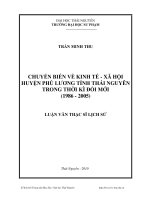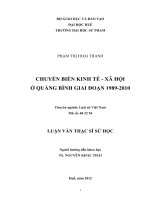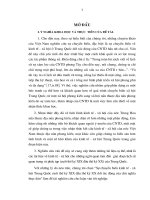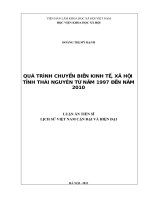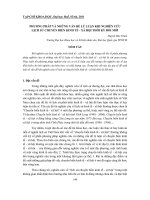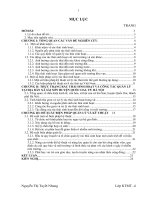Chuyển biến kinh tế xã hội xã Sài Sơn, huyện Quốc Oai, Hà Nội giai đoạn 1986 – 2010
Bạn đang xem bản rút gọn của tài liệu. Xem và tải ngay bản đầy đủ của tài liệu tại đây (232.24 KB, 22 trang )
VIETNAM NATIONAL UNIVERSITY, HANOI
INSTITUTE OF VIETNAMESE STUDIES AND DEVELOPMENT SCIENCES
VU THU HUYEN
SOCIO-ECONOMIC TRANSFORMATION OF SAI
SON COMMUNE, QUOC OAI DISTRICT, HA NOI
CITY IN PERIOD FROM 1986 TO 2010
MASTER THESIS
MAJOR: VIETNAMESE STUDIES
HANOI, 2014
VIETNAM NATIONAL UNIVERSITY, HANOI
INSTITUTE OF VIETNAMESE STUDIES AND DEVELOPMENT SCIENCES
VU THU HUYEN
SOCIO-ECONOMIC TRANSFORMATION OF SAI
SON COMMUNE, QUOC OAI DISTRICT, HA NOI
CITY IN PERIOD FROM 1986 TO 2010
Master thesis, major: Vietnamese studies
Code: 60 22 01 13
Supervisor: Prof.Dr. Truong Quang Hai
Hanoi, 2014
CONTENTS
INTRODUCTION ......................................................................................... 4
1. Rationale of the thesis .......................................................................................4
2. Listerature review .............................................................................................5
3. Objectives, research scope and research tasks...............................................7
4. Material resources and research methods ....................................................10
5. Contribution of the thesis ...............................................................................11
6. The structure of the thesis ..............................................................................12
Chapter
1
THEORETICAL
BASIS
OF
RESEARCHING
SOCIO-
ECONOMIC TRANSFORMATION IN THE PERIOD OF DOI MOI AND
INTRODUCTION TO SAI SON COMMUNE ..Error! Bookmark not defined.
1.1. Theoretical basis of researching socio-economic transformation in the
period of “Doi Moi” ............................................ Error! Bookmark not defined.
1.1.1. Basic concepts ........................................ Error! Bookmark not defined.
1.1.2. Factors affecting the socio-economic rural Sai Son in Doi Moi era
.......................................................................... Error! Bookmark not defined.
1.2. Overview of Sai Son commune ................... Error! Bookmark not defined.
1.2.1. Natural conditions of Sai Son communeError!
Bookmark
not
defined.
1.2.2. History and people of Sai Son ............... Error! Bookmark not defined.
1.2.3. Overview of socioeconomic situation of Sai Son commune before 1986
.......................................................................... Error! Bookmark not defined.
Sub-conclusion ..................................................... Error! Bookmark not defined.
Chapter 2 BASIC ECONOMIC TRANSFORMATIONS OF SAI SON
COMMUNE FROM 1986 TO 2010 ....................Error! Bookmark not defined.
2.1. Basic economic transformations of Sai Son commune from 1986 to
1996....................................................................... Error! Bookmark not defined.
2.1.1. Transformation in the operation of agricultural cooperatives and land
using rights....................................................... Error! Bookmark not defined.
1
2.1.2. Economic restructuring in the period 1986-1996 of Sai Son
commune ......................................................... Error! Bookmark not defined.
2.2. Economic transformation of Sai Son commune in the period 19962010 ...................................................................... Error! Bookmark not defined.
2.2.1. The important changes of the units of administrative boundaries and
preferential policies of investment situation ... Error! Bookmark not defined.
2.2.2. Conversion of land use purpose ............ Error! Bookmark not defined.
2.2.3. Economic restructuring in the period 1996-2010Error!
Bookmark
not defined.
2.2.4. Internal transformation of agriculture . Error! Bookmark not defined.
2.2.5. Transformations of Industry-Handicraft of Sai Son commune in the
phase 1996-2010 .............................................. Error! Bookmark not defined.
2.2.6. Transformations of Commerce - Services - TourismError! Bookmark
not defined.
2.2.7. The situation of receiving projects ........ Error! Bookmark not defined.
2.2.8. The situation of constructing new ruralError!
Bookmark
not
defined.
2.2.9. The achievements of the basic constructionError!
Bookmark
not
defined.
Sub-conclusion of chapter 2 ................................ Error! Bookmark not defined.
Chapter 3 BASIC SOCIAL TRANSFORMATIONS OF SAI SON
COMMUNE FROM 1986 TO 2010 ....................Error! Bookmark not defined.
3.1. Restructuring of labor and employment of Sai Son commune ....... Error!
Bookmark not defined.
3.1.1. Restructuring of labor by sector ............ Error! Bookmark not defined.
3.1.2. Labor structure by level ......................... Error! Bookmark not defined.
3.1.3. Changes of labor psychology ................ Error! Bookmark not defined.
3.1.4. Job creation ............................................ Error! Bookmark not defined.
3.2. Completion level of education-training and medical of the commune
............................................................................... Error! Bookmark not defined.
2
3.2.1. Education and training ......................... Error! Bookmark not defined.
3.2.2. Medical service ...................................... Error! Bookmark not defined.
3.3. Transformations of material life ................ Error! Bookmark not defined.
3.3.1. Income - living standard........................ Error! Bookmark not defined.
3.3.2 Poverty situation and the gap between rich and poorError! Bookmark
not defined.
3.4. Transformations of cultural and spiritual lifeError!
Bookmark
not
defined.
3.4.1. Changes of the way of using spare timeError! Bookmark not defined.
3.4.2. Changes in neighbor relations .............. Error! Bookmark not defined.
3.5. Negative changing of environment ............. Error! Bookmark not defined.
3.6. The situation of security and order, social securityError! Bookmark not
defined.
Sub-conclusion chapter 3 .................................... Error! Bookmark not defined.
CONCLUSIONS AND RECOMMENDATIONSError!
Bookmark
not
defined.
CONCLUSIONS ................................................. Error! Bookmark not defined.
RECOMMENDATIONS.................................... Error! Bookmark not defined.
REFERENCES ............................................................................................ 13
SCHEDULE .......................................................Error! Bookmark not defined.
3
INTRODUCTION
1. Rationale of the thesis
Comprehensive socioeconomic process of Doi Moi in our country has gone
through journey of more than twenty years (1986-2010) and transformed socioeconomic aspects of Vietnam towards industrial moderniration. Doi Moi has created
two trends of industrialization - modernization and urbanization at a rapid speed.
The areas impacted the most by two trends are suburban areas, particularly suburb
areas. Thus, the appearance of agriculture, rural areas and farmers of Vietnamese
suburban areas also changes notably. In addition to the opportunities and
advantages that those trends brought these areas face many challenges and
difficulties.
Sai Son commune of Quoc Oai district is a suburban agricultural commune
in Hanoi. From 1986 to now it is mostly affected by policies of Doi Moi process
and urbanization trend; especially in recent decade, increasing suburban factor has
enhanced its manitudes. The dynamic of inhabitants catching up with changes
inpolicies creates positive movement in Sai Son rural. Local authorities and
households here, by learning from experiences, gain achievements in the economic
restructuring in general and agricultural restructuring in particular, (developing
towards the production of goods ). In the district, industrial parks and urban
neighborhoods have been invested. There are structural changes in cultivation,
livestock breeding, agro-processing, in direction of gradually building a modern
urban area. This process not only changes the structure of physical space, but it also
changes the living conditions, living labor, advancement opportunities and the
lifestyle, the psychology of the people living here. Here there are some new and
modern elements of urban culture, the dissemination of cultural products, of literary
or artistic value, importing of lifestyle, communication style, and civilized
behavior..., known as new cutural nuance of the village. It can be said that the
appearance of agriculture, rural area and farmers is more modern and civilized
despite of inevitably negative elements existing or arising.
4
Studying socio-economic transformations in the suburban areas since Doi
Moi has been of interest by many authors but the focus is only on the first 10 years
of Doi Moi and limited within the study area of a district. There has been no prior
mention on Sai Son commune in the period from 1986 to present, during which
socio-economic situation of suburban areas as Sai Son was significantly under of
nationwide modernization and urbanization. There were some studies on this
problem, however the strongest transformations including positive and negative
impacts of the above factors were not yet mentioned. Moreover, they are often
studies of the specialized sciences such as history, economics, geography ... with
incomprehensive results. Therefore, based on the interdisciplinary approach in area
studies, the study on“Socio-economic transformation of Sai Son commune, Quoc
Oai district, Ha Noi city in period from 1986 to 2010” has scientific as well as
practical significance and urgent nature.
2. Listerature review
The contents of the study are economic transformations of a suburban
countryside, which is an agricultural village so the transformations are also
associated with agriculture, rural and farmers. Researching socio-economic
transformations in rural areas since the beginning of Doi Moi has to stem
necessarily from the situation of agriculture, rural and farmers in Vietnam before
Doi Moi process. There are many research works referring to the subjects and this
era of Vietnam such as : The real situation of agriculture, rural areas and farmers in
Vietnam (1976-1990) ( Nguyen Sinh Cuc , 1991 ) [9] ; Socioeconomic issues
through three surveys of agriculture, industry, housing ( Le Van Toan , 1991 ) [ 77];
Surveying forms of cooperative organization of farmers in our country today ( Dao
The Tuan , 1995) [80] …
Researching works on this issue provided an overview of the current state of
agriculture and socioeconomic rural in the time of Doi Moi with many limitations
such as the obviousness of psychology and traditional production practices; pure
agricultural structure, rice monoculture, intensive food production with selfsufficiency, and economic sectors in a long time only allowed to exist in two forms
5
of state-owned and collective; inefficient management model of concentration
and bureaucratic habits; poor market in general, especially the rural market;
common phenomenon of poor in rural; unemployment of rural workers; poor
infrastructure of the rural ... (Nguyen Dang Chat, 1994) [8]. At the same time,
they posed and solved many theoretical problems of the road for rural to go to
socialism, of the successes and failures of cooperation, collective agriculture and
rural areas throughout the country.
From that current situation, many authors focused on studying the
transformations in the society and economy in rural areas of Hanoi and some other
localities in the country since the Doi Moi, such as: the economy and society of
rural in Gia Lam district - Ha Noi on Doi Moi process (Tran Thi Tuong Van, 2004)
[89]; Transformation of villages in Vietnam Red River Delta nowadays (To Duy
Hop, 2000) [26]; Transformations of socioeconomic structure of a commune in the
Red River Delta, Phung Thuong commune (Ha Tay) from 1954 to now (Bui Hong
Van, 2002) [87]; Socioeconomic transformations of Phu Luong district, Thai
Nguyen province in Doi Moi era (1986-2005) (Tran Minh Thu, 2010) [68] …
The Doi Moi process in rural suburb areas of Hanoi has differences
compared to other rural areas because it is associated with the process of
urbanization. Some aspects of the urbanization process in the coastal area of Hanoi
in Doi Moi process are mentioned in many publications. Socioeconomic
transformations of suburban areas in Hanoi in urbanization process happen in all
sectors: occupational structure, income, standard of living, housing and
infrastructure; physical and spiritual life (Nguyen Huu Minh, 2005) [42, pg.56]. In
particular, the most significant transformation is in the career structure. Due to the
impact of urbanization, land area losing, farmers lost key production materials.
They take compensation but do not know to create opportunities to convert their
careers. Besides, the ineffective interest of authorities makes them struggle to find a
way to survive. This poses the problem of converting jobs before whirlwind of
urbanization. This problem has also been given many authors as the urgent social
problems needed to be studied and solved such as: Employment for farmers in the
6
Red River delta in the process of industrialization and modernization, (Bui Thi
Ngoc Lan, 2007) [33]; Solving the problems of labor and employment in the
agricultural and rural urbanization as well as industrialization process (Nguyen Huu
Dung, 2004) [12]... Some other urgent problems of migration and environment due
to urbanization such as: free migration during urbanization and its impact on the
environment of Hanoi city (Do Thi Thanh Hoa, 1999) [25], the main solutions to
overcome the effects of urbanization on environment of urban areas in Hanoi
(Nguyen Huu Sung, 1995) [59] ... A number of implications of urbanization in
suburban areas referred such as growing differentiation in a part of the population
[46, p.134]…
Overall, the recent research works with the research direction closing to the
one of the thesis provided the approaches, investigation, so the author can construct
the best research direction suitable to chosen local. It can be said, there is no work
to comprehensively study economy and society of Sai Son commune in the period
from 1986 to 2010. Therefore, based on area studies with deep investigation, a
systematic analysis of these issues of economic restructuring, occupational
structure, lifestyle changes ... and impact of these factors on the total socioeconomic transformations of Sai Son commune in Doi Moi affected by the trend of
modernization and urbanization becomes a subject having scientific practical and
urgent significance. It should be studied seriously, creating a scientific basis for
evaluating the current situation, learning lessons and orienting policies and
sustainable development for the local.
3. Objectives, research scope and research tasks
3.1. Objectives
Since the comprehensive implementation of the Party and State on
socioeconomic policies in Doi Moi (1986), Vietnamese rural in general and Sai Son
rural in particular have many positive signs. With the policies of agricultural
modernization and rural development of the Party and State, trend of urbanization
and the advantages of a suburban area, socio-economic situation of the Sai Son has
significant growth. There are many transformations of economic structure in the
7
direction of industrialization; the living quality of residents is enhanced. With
modernity, lifestyle of local community directs to the structure of an urban
community. Thus, the thesis aims to objectives being main socio-economic
transformations of Sai Son commune since Doi Moi. By dividing into small stages,
the research will clarify the main impacts of factors on the economy and society of
locality at each stage; also assess the positive factors inherited and negative factors
drawn to learn for the growth of next period. In those objectives, Sai Son resident
community is the subject making transformations. Thus, the thesis also aims to
explore the lifestyle of inhabitants in the past and present.
3.2. Research aims
The thesis aims to clearly realize the socio-economic situation and
transformations of Sai Son commune in the period 1986-2010; to assess those
transformations and to propose solutions for local sustainable development.
3.3. Research tasks
Clarifying the theoretical basis, the basic concepts related to issues
Learning, analyzing and evaluating economic transformations of Sai Son
commune through contents: The economic restructuring, the restructuring of the
agricultural sector; Status of conversion process of land uses; especially agricultural
land; The transformation of non-agricultural economic sectors and increasing
important role of them; The development and improvement of local infrastructure;
the situation of building new countryside.
Learning, analyzing and evaluating economic transformations of Sai Son
commune through contents: The transformation in the structure of labor employment; status of poverty and the gap of rich and poor; perfect level of local
education and training of medical; The transformation of material - cultural spiritual life
Based on the research results obtained, suggesting some recommendations
and solutions to improve policies of development and management of Sai Son
commune.
8
3.4. Research scope
The thesis researches socioeconomic transformations of Sai Son commune,
Quoc Oai district, Hanoi in the period 1986-2010.
About the time:
Thesis limits research time from 1986 to 2010. During that time, Sai Son
commune was influenced by a lot of larger transformations such as: beginning
comprehensive reformation and achieving many significant accomplishments,
accelerating the progress of industrialization and modernization when merging into
the administrative boundaries of Hanoi, officially becoming a part of the capital.
About Space:
Research site consists of 6 villages in the commune, they are: the village of
Phuc Duc, Thuy Khue, Da Phuc, Sai Khe, Khanh Tan and Nam Trai.
Scientific scale:
Due to the limitation of local storage socio-economic materials of Saison in
the first ten years of Doi Moi remains no more. The author had to use the method of
directly interviewing the officials in this period of time, old local people and the
method of comparing to other localities in the same district, province, and period to
generalize information about the socio-economic differences of Sai Son commune
compared to the period time before Doi Moi.
Sai Son commune covers an natural area of 1007.08 ha, with more than
4,000 households, divided into 6 villages as described above. During the field
survey, the author distributed 200 questionnaires to all rural households.
Interviewed households were randomly selected based on the following criteria:
road access, having sidelines, priority family...
In researching economic transformations, the researching time is divided into
two periods particularly the period of first ten-year of Doi Moi from 1986 to 1996
and the period from 1996 to 2010. This division is based on materials the author
gathered and way of summarizing and evaluating achievements of Doi Moi from
other studies.
9
In researching social transformations: Through the synthesis of investigation
results and the experience of being a local person, the author realizes the clear
changes in income, housing, toilets, the use of the furniture facilities, the use of
leisure time, neighborhood relations in Saison from the 2000s onwards. So, in a
content having field survey results, the transformations are reflected through the
time before and after the year 2000.
4. Material resources and research methods
4.1. Material resources
The thesis mainly exploits and uses the following resources:
1/ Bibliographies, reports, texts, tables, statistics... of the commune and
district.
2/ Documentation from field surveys
Using the field methods, sociological surveys by questionnaires, focusing
surveys on some key issues:
- Status of human labor, occupation of the members in farmer families in the
commune.
- Transformations in economic activities of farmers in the process of
urbanization due to selling their land or land acquisition by the State, land using
transition, or not using land for agricultural production.
- Changes of environmental sanitation conditions affecting daily life and
agricultural production.
- The transformation of environment, neighborhood relations of local people.
- Transformations in the physical, cultural and spiritual life of local people
due to direct impacts of process of urbanization.
3/ Research works related to the previous authors.
Of three above material resources, the first and second ones play important roles.
4.2. Research methods
Stemming from the object and proposed research tasks, the thesis applies
multidisciplinary and interdisciplinary approach. The knowledge of geography,
ecology, geology ... is used to assess the natural conditions. Knowledge of social
10
sciences such as history, ethnography, cultural studies, economics, sociology ... is
used for researching the original characteristics, population structure, economic
structure and policies from time to time ... Besides, the thesis also uses a number of
methods:
Methods of inheriting: based on the studies of economic, cultural and social
transformations of suburb areas in the urbanization process; a number of
information, documents of Sai Son commune , including information regarding the
rationale, economy, culture, society ... the author acquires, inherits previous
research results from them.
Methods of statistic, synthesis and analysis of materials: After collecting
research works related to research issues needed to be clarified, and information,
data, statistics related to economy as well as society of Sai Son commune, we use
statistical method to resources related to subject, analysis and process local
socioeconomic data in order to clarify the rules of transformation, characteristics of
transformation before proposing more practical solutions.
Method of sociological surveys: To gather field materials, the author uses the
method of field surveys in local, uses socioeconomic questionnaires, deeply
interviews managers and residents in surveyed area to understand the psychology as
well as personal opinion of the interviewees.
Historical method and logical method are used in research process. These
methods help to recognize, evaluate and interpret things, the phenomenon in the
depth of history.
5. Contribution of the thesis
1/ Through collecting and analyzing archives of the commune and district as
well as fieldwork materials, the thesis reconstructs a specific socioeconomic context
of Sai Son commune from early Doi Moi process up to now. Thereby we can see
major transformations of socioeconomic structure under the impact of innovation
policy and urbanization trends.
2/ Based on practical limitations, negative transformations, the thesis
proposes a number of recommendations making orientation for socioeconomic
11
development of the commune in the future. The thesis can be references for those
who want to learn about Sai Son commune in the Doi Moi period or for leaders of
the commune in development planning.
6. The structure of the thesis
Besides the introduction, conclusion, recommendations, references and
appendix, the main contents of the thesis are presented in three chapters:
Chapter 1. Theoretical basis of researching socio-economic transformation
in the period of Doi Moi and introduction to Sai Son commune
Chapter 2. Basic economic transformations of Sai Son commune from 1986 to 2010
Chapter 3. Basic social transformations of Sai Son commune from 1986 to 2010
12
REFERENCES
1. Nguyen Quang An (2000), Vietnam - place and boundary changes of
administrative units from 1945 to 1997, National Political Publisher.
2. Vu Dinh Bach, Ngo Dinh Giao, Hoang Dat… (1997) Innovation and
synchronously implement policies and economic management mechanism,
National Political Publisher, 1997.
3. Do Quoc Bao (editor) (2010), Culture and History of Quoc Oai, Labour
Publisher.
4. Hoang Chi Bao (2008), Social transformation in Vietnam through more than
20 years of Doi Moi, Summary record of the third International Conference
of Vietnamese studies, Vietnam National University, Hanoi.
5. Nguyen Tran Bat, 2005, Reformation and Development, Publisher of writer
association, Hanoi
6. Nguyen Dang Chat (1994), Economic transference in Vietnamese rural,
Scientific doctoral thesis of Economics.
7. Statistic department of Quoc Oai district (2012), the questionnaire No. 02.A
THN/TĐTKT-HQ: The number of establishments and employees of
individual business establishments in Quoc Oai District.
8. Statistic department of Quoc Oai district (2012), the questionnaire No. 2.1
THN/TĐTKT-HQ: The number of establishments and employees of
individual business establishments by sectors and the status of business
registration in Quoc Oai District.
9. Nguyen Sinh Cuc (1991), Current situation of agriculture, rural areas and
farmers of Vietnam (1976-1990), Statistical Publisher, Hanoi.
10. Le Dang Doanh (1997), Scientific basis of economic reformation in
Vietnam, National Political Publisher.
11. Nguyen Huu Dung, Tran Huu Trung (1997), Regarding to employment
policies in Vietnam, National Political Publisher.
13
12. Nguyen Huu Dung (2000), Strategy of employment security during
industrialization - modernization of Vietnam, Journal of Labor and Unions
No. 228.
13. The Dung, How fund of paddy land will be tomorrow, New Hanoi
newspaper, issued on 04.15.2008.
14. Nguyen Tien Dung (2002), Innovation and completing a number of policies
to accelerate transference of agricultural economic structure, Doctoral thesis
of Economics.
15. Nguyen
Xuan
Dung
(1995),
Some
orientations
for
promoting
industrialization - modernization in Vietnam during the period 1001-2010,
Social Science Publisher.
16. Pham Bao Duong (2008), Research of policy proposals of vocational
training for rural labors in 2020 (some case studies in northern Vietnam),
Hanoi.
17. Commune Party Committee of Sai Son (1998), The performance report 1998.
18. Commune Party Committee of Sai Son (2005), The 22nd report Party
Congress of Sai Son commune.
19. Commune Party Committee of Sai Son (2010), The 23rd report of Party
Congress of Sai Son commune.
20. Commune Party Committee of Sai Son, Report of business results of the
year 2000, 2001, 2006, 2007, 2008, 2009, 2010, 2011, 2012.
21. Cadastral of Sai Son commune (2010), Report of fluctuations of land area
according to using purpose in 2010 compared with 2005 and 2000.
22. Nguyen Huu Duc (1996), The impact of the economic management
mechanism to promotion of agricultural economic structure transference, A.
Doctoral thesis of Economics.
23. Ngo Van Gia (2007), Changes of traditional culture value in the village at
the edge of Hanoi city in the reformation era, National Political Publisher.
14
24. Ngo Dinh Giao (editor) (1996), Thoughts on industrialization modernization in our country: Some theoretical and practical issues,
National Political Publisher .
25. Do Thi Thanh Hoa (1999), free migration in the process of urbanization and
its impact on the environment of Hanoi, Doctoral thesis of History.
26. To Duy Hop (2000), The transformation of current Vietnamese villages in
the Red River Delta, Social Sciences Publisher, Hanoi.
27. Pham Van Hung (translation) (2007), Agricultural development and land
policy in Vietnam (policy briefs), Australian centre of international
agriculture research, Hanoi Agricultural University.
28. Nguyen Đinh Huong (1997), Reformation and economic development in
Vietnam, Science and Technology Publisher, Hanoi.
29. Nguyen Van Huong, Nguyen Ngoc Tien… (1996),
Strategy of
industrialization and modernization and the technological revolution,
National Political Publisher.
30. Vu Trong Khai, Current policy situation of agricultural development,
Vietnamese Agriculture newspaper on 07/09/2008.
31. Nguyen Van Khanh (2001), Structural transformation of land and
agricultural economy in the Red River Delta in the reformation era (through
surveying some villages), National Political Publisher.
32. Nguyen Van Khanh (editor) (1990), Management of rural society in our
nation at present: Some problems and solutions, National Political Publisher.
33. Bui Thi Ngoc Lan (editor) (2007), Employment of farmers in the Red River
delta during the process of industrialization and modernization, Political
Theory Publisher, Hanoi.
34. Trinh Duy Luan (2009), Curriculum of urban sociology, National University
Publisher.
35. Tran Duc Luong, Nguyen Duc Binh, Nguyen Duy Quy…, Reformation for
development, National Political Publisher, 2002.
15
36. Revolution history of Cam Dinh Party (1945-2010), Labor Publisher.
37. Revolution history of Sai Son Party in the period 1930-1945, Labor
Publisher.
38. Revolution history of Sai Son Party in the period 1945-1954, Labor
Publisher.
39. Revolution history of Sai Son Party in the period 1954-1975, Labor
Publisher.
40. Revolution history of Phu Dong Party (1930-2005), Labor Publisher.
41. Revolution history of Ung Hoa Party (1930-2010), Labor Publisher.
42. Nguyen Huu Minh (2005), Socio-economic transformation in the suburban
areas of Hanoi in the urbanization process, Journal of Sociology, No. 1.
43. Pham Xuan Nam (editor) (1991), Social and economic innovation:
achievements, problems and solutions, Social sciences Publisher.
44. Vu Van Nam (2009), Development of sustainable agricultural in Vietnam,
Times Publisher.
45. Nguyen Van Ngung (2005), Innovation and completion a number of policies
to accelerate economic transference of agriculture, Doctoral thesis of
economic.
46. Nguyen The Nha (1996), agricultural innovation and development in rural,
Agriculture Publisher.
47. Council of Ministers’ decree of innovational management policies towards
the agricultural sector, Agriculture Publisher, 1988.
48. Dang Phong (2002), Economic history of Vietnam 1945-2000, Social
science publisher,.
49. Statistics Division of Quoc Oai district, Statistical yearbook of Quoc Oai
district from 1995 to 2011.
50. Phung Huu Phu (2009), Urbanization in Vietnam: from the perspective of
agriculture, rural areas and farmers, Journal of Propaganda, No. 3.
51. Nguyen Trong Phuc, Đoi moi in Vietnam: Reality and theoretical cognitive,
National Political Publisher.
16
52. Doan Manh Phuong (editor) (2006), Vietnam – Achievements of 20 years of
Doi Moi, Culture and information Publisher.
53. Ngo Thi Phuong (2011), The social transformation in Vietnamese rural due
to the using purpose conversion of agricultural land (through case study of
Ninh Binh), Summary record of the third International Conference of
Vietnamese studies.
54. Chu Huu Quy (1996), Comprehensive development of socioeconomic and
agricultural rural Vietnam, National Political Publisher.
55. Pham Dang Quyet (2012), Research and test of methods calculating
criteria of surplus labor of agricultural sector in Vietnam, Institute of
statistical science.
56. Department of Labor - Invalids and Social Affairs, surveying materials
determining poor households and nearly poor ones according to national
standards for formation standards of poverty in Hanoi the period from 2011
to 2015.
57. Dang Kim Son, Hoang Thu Ha (editor) (2002), A number of issues of
agricultural development in rural areas, Institute for Central Economic
Management, Statistic Publisher.
58. Nguyen Danh Son (editor) (2010), Agriculture, rural and farmers in
Vietnam during the country's development towards modernization trend,
Social sciences publishe.
59. Nguyen Huu Sung (1995), The major solutions to overcome the effects of
urbanization on urban environments Hanoi, Doctoral thesis of economics.
60. Du Phuoc Tan (2005), The socioeconomic problems posed to the suburban
economic region during the urbanization process, Institute of Economics, Ho
Chi Minh city.
61. Truong Quang Thao (2001), Urban studies, Construction Publisher
62. Nguyen Xuan Thao (2004), Contributing to the sustainable development of
rural Vietnam, National Political Publisher.
17
63. Hoang Thi Thanh (1995), Vietnamese farmers’ economic situation in the
renovation process of agricultural management mechanisms, A. Scientific
doctoral of Economics.
64. Bui Tat Thang (editor) (1997), The factors influencing the restructure of
economic sectors in the period of industrialization in Vietnam, Social science
publisher.
65. Dang Van Thang, Pham Ngoc Dung…(2003), economic structural
transference of industry, agriculture in the Red River Delta: Current
situation and Prospects, National Political Publisher.
66. Tran Dinh Thien (2002), Industrialization and modernization in Vietnam:
itinerary outlines, National Political Publisher.
67. Le Si Thiep (editor) (2002),Trang Thi Tuyet, Nguyen Thi Phuong Lan
Strategy of socioeconomic development, National University Publisher.
68. Tran Minh Thu (2010), Socioeconomic transformation of Phu Luong
district, Thai Nguyen province during Doi Moi era (1986-2005), Master
thesis of History, Thai Nguyen University.
69. Doan Xuan Thuy (editor) (2011), Current assistance policies of agricultural
production in Vietnam, National Political Publisher.
70. Nguyen Van Tiem (1994), Developing forms of economic cooperation in
agriculture in Vietnam, A. Scientific Doctoral of Economics.
71. Truong Thi Tien (1996), Doi Moi process of management mechanisms of
agricultural economy in Vietnam from 1981 to 1995, A. Scientific Doctoral
of History.
72. Nguyen Van Tien, Ho Si Cuc… (1999), Results of socioeconomic survey of
households 1994-1997, Statistic Publisher.
73. Nguyen Van Tien (2001),, Chua Thay Relic (Ha Tay), Doctoral of History.
74. Nguyen Van Tien (2001), Chua Thay (Thiên Phúc pagoda), Social science
publisher.
18
75. Nguyen Tiep (2008), Jobs for employees in conversion process of
agricultural land using purposes, Communist Journal.
76. Pham Hong Tinh, Reorganization of residential credit fund in the Doi Moi
process and socioeconomic development in Vietnamese rural, A. Doctoral
thesis of Economics, National Economics University.
77. Le Van Toan (editor) (1991), Economic and living issues through three
surveys of agriculture, industry and resident, Statistic Publisher, Hanoi.
78. Nguyen Duc Truyen (2003), Household’s economic situation and social
relations in rural of Red River delta in Doi Moi era, Social sciences
Publisher.
79. Nguyen Ke Tuan (editor) (2006), Industrialization - modernization of
agriculture and rural areas in Vietnam: The orientation and steps, National
Political Publisher.
80. Dao The Tuan (1995), Surveying current forms of farmers’ cooperative
organization in our country, National political Publisher.
81. General Statistics Office (2011), the investigation report of labor and
employment in Vietnam in the year 2010, Statistic Publisher.
82. General Statistics Office (1996), Vietnamese infrastructure through 10 years
of Doi Moi era (1985-1995), Statistic Publisher.
83. General Statistics Office (2012), Migration and urbanization in Vietnam:
Current situation, trends and differences, Census of population and housing
in Vietnam in 2009, Statistics publisher .
84. General Statistics Office (1996), movement and socioeconomic current
situation of Vietnam over 10 years of Doi Moi era (1986-1995), Statistic
Publisher.
85. Committee of Sai Son commune, 1998, Report on results of leading through
10 years of innovation 1986-1996.
86. Committee of Sai Son commune, Report explaining data of land inventory in
2010.
19
87. Bui Hong Van (2002), Transformation of socioeconomic structure of the
one of the commune in Red River Delta, Phung Thuong commune (Ha Tay in
the past) from 1954 to present, Scientific Doctoral thesis of History.
88. Tran Thi Tuong Van (2002), The process of socioeconomic transformation
of rural in Gia Lam district of Hanoi city from 1981 to 1996, Doctoral thesis
of History, Institute of History.
89. Tran Thi Tuong Van (2009), Society and economy of rural in Gia Lam
district, Hanoi city in Doi Moi process, Social Sciences Publisher.
90. Institute of Religious Research (2012), summary record of scientific
conference "Thay Pagoda and holy progenitor".
91. Nguyen Nhu Y (1998), Great Vietnamese dictionary, Publisher of culture
and information.
92. dangcongsan.vn/cpv/modules/news
20

